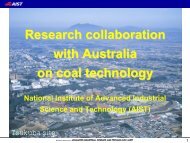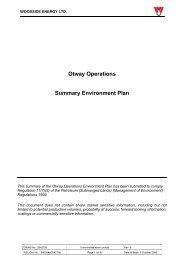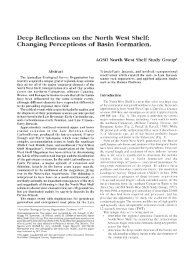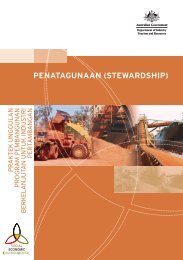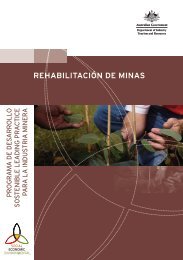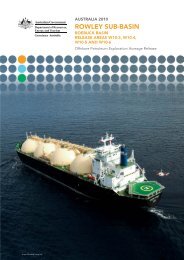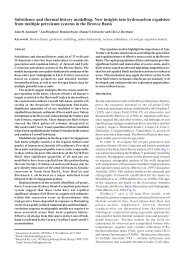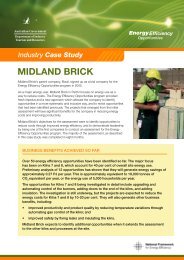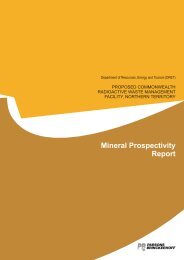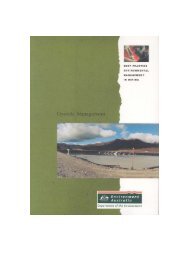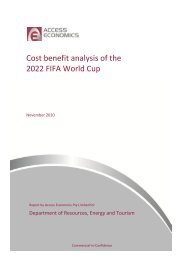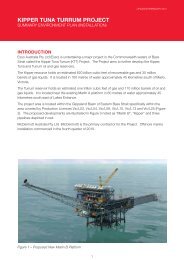A guide to leading practice sustainable development in mining
A guide to leading practice sustainable development in mining
A guide to leading practice sustainable development in mining
You also want an ePaper? Increase the reach of your titles
YUMPU automatically turns print PDFs into web optimized ePapers that Google loves.
Figure 4.10 – Black shale at Tom Price<br />
Risk <strong>in</strong> operations<br />
Introduction<br />
The environmental and economic risks of m<strong>in</strong><strong>in</strong>g are generally well identified and<br />
managed, but social risks rema<strong>in</strong> a more challeng<strong>in</strong>g area for the m<strong>in</strong>erals <strong>in</strong>dustry.<br />
Social risk can manifest <strong>in</strong> a variety of ways—through Indigenous issues, community<br />
<strong>development</strong>, workforce issues and so on. The relationships between social,<br />
environmental and economic risks are often not clearly def<strong>in</strong>ed or easy <strong>to</strong> clarify—yet<br />
they must be <strong>in</strong>corporated <strong>in</strong><strong>to</strong> risk management <strong>to</strong> ensure the m<strong>in</strong>erals <strong>in</strong>dustry<br />
contributes strongly <strong>to</strong> <strong>susta<strong>in</strong>able</strong> <strong>development</strong>.<br />
The Argyle m<strong>in</strong>e provides an example of the use of risk management <strong>in</strong> a technically,<br />
geographically, environmentally and socially complex operation (see LP Risk p.10).<br />
In December 2005, Rio T<strong>in</strong><strong>to</strong> approved a major <strong>in</strong>vestment <strong>to</strong> extend the Argyle<br />
Diamonds m<strong>in</strong>e <strong>in</strong><strong>to</strong> an underground block cave operation. As would be expected<br />
for an <strong>in</strong>vestment of this size, the feasibility study <strong>in</strong>cluded a comprehensive risk<br />
assessment cover<strong>in</strong>g all aspects of the proposal. These <strong>in</strong>cluded not only the<br />
f<strong>in</strong>ancial and technical risks associated with the change <strong>to</strong> a new m<strong>in</strong><strong>in</strong>g method,<br />
but also the environmental and social implications. The team charged with assess<strong>in</strong>g<br />
these <strong>susta<strong>in</strong>able</strong> <strong>development</strong> implications focused, <strong>in</strong> particular, on the impacts of<br />
the decision on two communities, the first the ma<strong>in</strong>ly Indigenous regional population<br />
of the East Kimberley area where the m<strong>in</strong>e is located and the second the large<br />
number of people <strong>in</strong>volved <strong>in</strong> process<strong>in</strong>g Argyle’s diamonds downstream <strong>in</strong> India—an<br />
estimated 220 000 workers. Team-based workshops were used <strong>to</strong> address the social<br />
risks and opportunities for the two community areas. The outcomes were readily<br />
<strong>in</strong>tegrated <strong>in</strong><strong>to</strong> the overall risk register for the project. New controls were developed<br />
for key areas and the residual risks recalculated. The social risks were among the<br />
A GUIDE TO LEADING PRACTICE SUSTAINABLE DEVELOPMENT IN MINING 111



